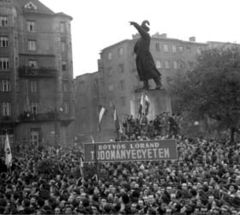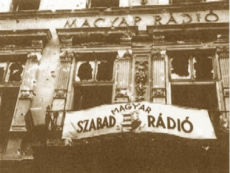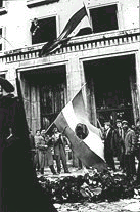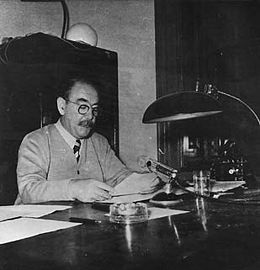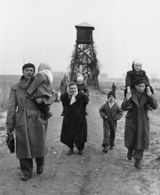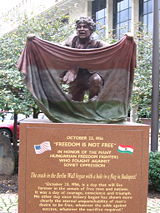Hungarian Revolution of 1956
2008/9 Schools Wikipedia Selection. Related subjects: General history
| Hungarian Revolution of 1956 | |||||||
|---|---|---|---|---|---|---|---|
| Part of the Cold War | |||||||
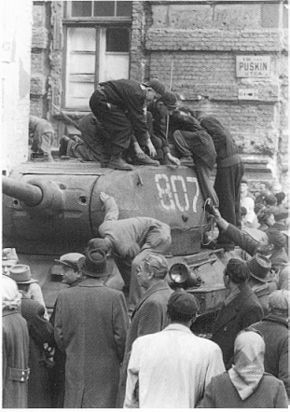 Hungarians inspecting a captured Soviet tank in Budapest |
|||||||
|
|||||||
| Belligerents | |||||||
| Commanders | |||||||
| Various independent militia leaders | |||||||
| Strength | |||||||
| 150,000 troops, 6,000 tanks |
Unknown number of militia and rebelling soldiers | ||||||
| Casualties and losses | |||||||
| (Soviet casualties only) 722 killed 1,251 wounded |
2,500 killed (est.) 13,000 wounded (est.) |
||||||
The Hungarian Revolution of 1956 was a spontaneous nationwide revolt against the Stalinist government of Hungary and its Soviet-imposed policies, lasting from October 23 until 10 November 1956. It began as a student demonstration which attracted thousands as it marched through central Budapest to the Parliament building. A student delegation entering the radio building in an attempt to broadcast their demands was detained. When the delegation's release was demanded by the demonstrators outside, they were fired upon by the State Security Police (ÁVH) from within the building. The news spread quickly and disorder and violence erupted throughout the capital.
The revolt spread quickly across Hungary, and the government fell. Thousands organized into militias, battling the State Security Police (ÁVH) and Soviet troops. Pro-Soviet communists and ÁVH members were often executed or imprisoned, as former prisoners were released and armed. Impromptu councils wrested municipal control from the Communist Party, and demanded political changes. The new government formally disbanded the ÁVH, declared its intention to withdraw from the Warsaw Pact and pledged to re-establish free elections. By the end of October, fighting had almost stopped and a sense of normality began to return.
After announcing a willingness to negotiate a withdrawal of Soviet forces, the Politburo changed its mind and moved to crush the revolution. On 4 November, a large Soviet force invaded Budapest. Hungarian resistance continued until 10 November. An estimated 2,500 Hungarians died, and 200,000 more fled as refugees. Mass arrests and denunciations continued for months thereafter. By January 1957, the new Soviet-installed government had suppressed all public opposition. These Soviet actions alienated many Western Marxists, yet strengthened Soviet control over Central Europe, cultivating the perception that communism was both irreversible and monolithic.
Public discussion about this revolution was suppressed in Hungary for over 30 years, but since the thaw of the 1980s it has been a subject of intense study and debate. At the inauguration of the Third Hungarian Republic in 1989, 23 October was declared a national holiday.
Prelude
After World War II, the Soviet military occupied Hungary and gradually replaced the freely elected government with the Hungarian Communist Party. Radical nationalization of the economy based on the Soviet model produced economic stagnation, lower standards of living and a deep malaise. Writers and journalists were the first to voice open criticism, publishing critical articles in 1955. By October 22, 1956, University students had resurrected the banned MEFESZ student union, and staged a demonstration on October 23 which set off a chain of events leading directly to the revolution.
Postwar occupation
After World War II, Hungary fell under the Soviet sphere of influence and was occupied by the Red Army. By 1949, the Soviets had concluded a mutual assistance treaty with Hungary which granted the Soviet Union rights to a continued military presence, assuring ultimate political control.
Hungary began the postwar period as a multiparty free democracy, and elections in 1945 produced a coalition government under Prime Minister Zoltán Tildy. However, the Soviet-supported Hungarian Communist Party, which had received only 17% of the vote, constantly wrested small concessions in a process named " salami tactics", which sliced away the elected government's influence.
In 1945, Soviet Marshal Kliment Voroshilov forced the freely elected Hungarian government to yield the Interior Ministry to the Hungarian Communist Party. Communist Interior Minister László Rajk established the Hungarian State Security Police (Államvédelmi Hatóság, later known as the ÁVH), which employed methods of intimidation, false accusations, imprisonment and torture, to suppress political opposition. The brief period of multiparty democracy came to an end when the Hungarian Communist Party merged with the Social Democratic Party to become the Hungarian Workers' Party, which stood its candidate list unopposed in 1949. The People's Republic of Hungary was declared.
Political repression and economic decline
Hungary became a communist state under the severely authoritarian leadership of Mátyás Rákosi. The Security Police (ÁVH) began a series of purges in which dissidents were denounced as “ Titoists” or “western agents”, and forced to confess in show trials. Thousands of Hungarians were arrested, tortured, tried, and imprisoned in concentration camps or were executed, including ÁVH founder László Rajk.
The Rákosi government thoroughly politicized Hungary's educational system in order to supplant the educated classes with a "toiling intelligentsia". Russian language study and Communist political instruction were made mandatory in schools and universities nationwide. Religious schools were nationalized and church leaders were replaced by those loyal to the government. In 1949 the leader of the Hungarian Catholic Church, József Cardinal Mindszenty, was arrested and sentenced to life imprisonment for treason. Under Rákosi, Hungary's government was among the most repressive in Europe.
The postwar Hungarian economy suffered from multiple challenges. Hungary agreed to pay war reparations approximating US$300 million, to the Soviet Union, Czechoslovakia, and Yugoslavia, and to support Soviet garrisons. The Hungarian National Bank in 1946 estimated the cost of reparations as "between 19 and 22 per cent of the annual national income." In 1946, the Hungarian currency experienced marked depreciation, resulting in the highest historical rates of hyperinflation known. Hungary's participation in the Soviet-sponsored COMECON (Council Of Mutual Economic Assistance), prevented it from trading with the West or receiving Marshall Plan aid. Although national income per capita rose in the first third of the 1950s, the standard of living fell. Huge income deductions to finance industrial investment reduced disposable personal income; mismanagement created chronic shortages in basic foodstuffs resulting in rationing of bread, sugar, flour and meat. Compulsory subscriptions to state bonds further reduced personal income. The net result was that disposable real income of workers and employees in 1952 was only two-thirds of what it had been in 1938, whereas in 1949, the proportion had been 90 per cent. These policies had a cumulative negative effect, and fueled discontent as foreign debt grew and the population experienced shortages of goods.
International events
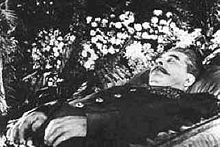
On March 5, 1953, Joseph Stalin died, ushering in a period of moderate liberalization during which most European communist parties developed a reform wing. In Hungary, the reformist Imre Nagy replaced Mátyás Rákosi, "Stalin's Best Hungarian Disciple", as Prime Minister. However, Rákosi remained General Secretary of the Party, and was able to undermine most of Nagy's reforms. By April 1955, he had Nagy discredited and removed from office. After Khrushchev's "secret speech" of February 1956, which denounced Stalin and his protégés, Rákosi was deposed as General Secretary of the Party and replaced by Ernő Gerő on July 18, 1956.
On May 14, 1955, the Soviet Union created the Warsaw Pact, binding Hungary to the Soviet Union and its satellite states in Central and Eastern Europe. Among the principles of this alliance were "respect for the independence and sovereignty of states" and "noninterference in their internal affairs".
In 1955, the Austrian State Treaty and ensuing declaration of neutrality established Austria as a demilitarized and neutral country. This raised Hungarian hopes of also becoming neutral and in 1955 Nagy had considered "...the possibility of Hungary adopting a neutral status on the Austrian pattern". Austrian neutrality altered the calculus of cold war military planning as it geographically split the NATO Alliance from Geneva to Vienna, thus increasing Hungary's strategic importance to the Warsaw Pact.
In June 1956, a violent uprising by Polish workers in Poznań was put down by the government, with scores of protesters killed and wounded. Responding to popular demand, in October 1956, the government appointed the recently rehabilitated reformist communist Władysław Gomułka as First Secretary of the Polish Communist Party, with a mandate to negotiate trade concessions and troop reductions with the Soviet government. After a few tense days of negotiations, on 19 October the Soviets finally gave in to Gomułka's reformist demands. News of the concessions won by the Poles - known as Polish October - emboldened many Hungarians to hope for similar concessions for Hungary and these sentiments contributed significantly to the highly-charged political climate that prevailed in Hungary in the second half of October 1956.
Social unrest builds
Rákosi's resignation in July 1956 emboldened students, writers and journalists to be more active and critical in politics. Students and journalists started a series of intellectual forums examining the problems facing Hungary. These forums, called Petõfi circles, became very popular and attracted thousands of participants. On October 6, 1956, László Rajk, who had been executed by the Rákosi government, was reburied in a moving ceremony which strengthened the party opposition, and later that month, the reformer Imre Nagy was rehabilitated to full membership in the Hungarian Communist Party.
On October 16, 1956, university students in Szeged snubbed the official communist student union, the DISZ, by re-establishing the MEFESZ (Union of Hungarian University and Academy Students), a democratic student organization, previously banned under the Rákosi dictatorship. Within days, the student bodies of Pécs, Miskolc, and Sopron followed suit. On October 22, students of the Technical University compiled a list of sixteen points containing several national policy demands. After the students heard that the Hungarian Writers’ Union planned on the following day to express solidarity with pro-reform movements in Poland by laying a wreath at the statue of Polish-born General Bem, a hero of Hungary's War of Independence (1848–49), the students decided to organize a parallel demonstration of sympathy.
Revolution
First shots
On the afternoon of October 23, 1956, approximately 20,000 protesters convened next to the Bem statue. Péter Veres, President of the Writers’ Union, read a manifesto to the crowd, the students read their proclamation, and the crowd then chanted the censored "National Song" ( Nemzeti dal), the refrain of which states: "We vow, we vow, we will no longer remain slaves." Someone in the crowd cut out the communist coat of arms from the Hungarian flag, leaving a distinctive hole and others quickly followed suit.
Afterwards, most of the crowd crossed the Danube to join demonstrators outside the Parliament Building. By 6 p.m., the multitude had swollen to more than 200,000 people; the demonstration was spirited, but peaceful.
At 8 p.m., First Secretary Ernő Gerő broadcast a speech condemning the writers' and students' demands, and dismissing the demonstrators as a reactionary mob. Angered by Gerő's hard-line rejection, some demonstrators decided to carry out one of their demands - the removal of Stalin's 30ft (10 m)-high bronze statue that was erected in 1951 on the site of a church, which was demolished to make room for the Stalin monument. By 9:30 p.m. the statue was toppled and jubilant crowds celebrated by placing Hungarian flags in Stalin's boots, which was all that was left of the statue.
At about the same time, a large crowd gathered at the Radio Budapest building, which was heavily guarded by the ÁVH. The flash point occurred as a delegation attempting to broadcast their demands was detained and the crowd grew increasingly unruly as rumors spread that the protesters had been shot. Tear gas was thrown from the upper windows and the ÁVH opened fire on the crowd, killing many. The ÁVH tried to re-supply itself by hiding arms inside an ambulance, but the crowd detected the ruse and intercepted it. Hungarian soldiers sent to relieve the ÁVH hesitated and then, tearing the red stars from their caps, sided with the crowd. Provoked by the ÁVH attack, protesters reacted violently. Police cars were set ablaze, guns were seized from military depots and distributed to the masses and symbols of the communist regime were vandalised.
Fighting spreads, government falls
During the night of October 23, Hungarian Communist Party Secretary Ernő Gerő requested Soviet military intervention "to suppress a demonstration that was reaching an ever greater and unprecedented scale." The Soviet leadership had formulated contingency plans for intervention in Hungary several months before. By 2 a.m. on October 24, under orders of the Soviet defense minister, Soviet tanks entered Budapest.
On October 24, Soviet tanks were stationed outside the Parliament building and Soviet soldiers guarded key bridges and crossroads. Armed revolutionaries quickly set up barricades to defend Budapest, and were reported to have already captured some Soviet tanks by mid-morning. That day, Imre Nagy replaced András Hegedűs as Prime Minister. On the radio, Nagy called for an end to violence and promised to initiate political reforms which had been shelved three years earlier. The population continued to arm itself as sporadic violence erupted. Armed protesters seized the radio building. At the offices of the Communist newspaper Szabad Nép unarmed demonstrators were fired upon by ÁVH guards who were then driven out as armed demonstrators arrived. At this point, the revolutionaries' wrath focused on the ÁVH; Soviet military units were not yet fully engaged, and there were many reports of some Soviet troops showing open sympathy for the demonstrators.
On October 25, a mass of protesters gathered in front of the Parliament Building. ÁVH units began shooting into the crowd from the rooftops of neighboring buildings. Some Soviet soldiers returned fire on the ÁVH, mistakenly believing that they were the targets of the shooting. Supplied by arms taken from the ÁVH or given by Hungarian soldiers who joined the uprising, some in the crowd started shooting back.
The attacks at the Parliament forced the collapse of the government. Communist First Secretary Ernő Gerő and former Prime Minister András Hegedűs fled to the Soviet Union; Imre Nagy became Prime Minister and János Kádár First Secretary of the Communist Party. Revolutionaries began an aggressive offensive against Soviet troops and the remnants of the ÁVH.
As the Hungarian resistance fought Soviet tanks using Molotov cocktails in the narrow streets of Budapest, revolutionary councils arose nationwide, assumed local governmental authority, and called for general strikes. Public Communist symbols such as red stars and Soviet war memorials were removed, and Communist books were burned. Spontaneous revolutionary militias arose, such as the 400-man group loosely led by József Dudás, which attacked or murdered Soviet sympathizers and ÁVH members. Soviet units fought primarily in Budapest; elsewhere the countryside was largely quiet. Soviet commanders often negotiated local cease-fires with the revolutionaries. In some regions, Soviet forces managed to quell revolutionary activity. In Budapest, the Soviets were eventually fought to a stand-still and hostilities began to wane. Hungarian general Béla Király, freed from a life sentence for political offenses and acting with the support of the Nagy government, sought to restore order by unifying elements of the police, army and insurgent groups into a National Guard. A ceasefire was arranged on October 28, and by October 30 most Soviet troops had withdrawn from Budapest to garrisons in the Hungarian countryside.
Interlude
Fighting had virtually ceased between 28 October and 4 November, as many Hungarians believed that Soviet military units were indeed withdrawing from Hungary.
The New Hungarian National Government
The rapid spread of the uprising in the streets of Budapest and the abrupt fall of the Gerő-Hegedűs government left the new national leadership surprised, and at first disorganized. Nagy, a loyal Party reformer described as possessing "only modest political skills", initially appealed to the public for calm and a return to the old order. Yet Nagy, the only remaining Hungarian leader with credibility in both the eyes of the public and the Soviets, "at long last concluded that a popular uprising rather than a counter-revolution was taking place". Calling the ongoing insurgency "a broad democratic mass movement" in a radio address on October 27, Nagy formed a government which included some non-communist ministers. This new National Government abolished both the ÁVH and the one-party system.
Because it held office only ten days, the National Government had little chance to clarify its policies in detail. However, newspaper editorials at the time stressed that Hungary should be a neutral, multiparty social democracy. Many political prisoners were released, most notably József Cardinal Mindszenty. Political parties which were previously banned, such as the Independent Smallholders and the National Peasants' Party, reappeared to join the coalition.
Local revolutionary councils formed throughout Hungary , generally without involvement from the preoccupied National Government in Budapest, and assumed various responsibilities of local government from the defunct communist party. By October 30, these councils had been officially sanctioned by the Hungarian Workers' (Communist) Party, and the Nagy government asked for their support as "autonomous, democratic local organs formed during the Revolution". Likewise, workers' councils were established at industrial plants and mines, and many unpopular regulations such as production norms were eliminated. The workers' councils strove to manage the enterprise whilst protecting workers' interests; thus establishing a socialist economy free of rigid party control. Local control by the councils was not always bloodless; in Debrecen, Gyor, Sopron, Mosonmagyaróvár and other cities, crowds of demonstrators were fired upon by the ÁVH, with many lives lost. The ÁVH were disarmed, often by force, in many cases assisted by the local police.
Soviet perspective
On October 24, the Presidium of the Central Committee of the Communist Party of the Soviet Union (the Politburo) discussed the political upheavals in Poland and Hungary. A delegation in Budapest reported that the situation was not as dire as had been portrayed. Khrushchev stated that he believed that Party Secretary Ernő Gerő's request for intervention on October 23 indicated that the Hungarian Party still held the confidence of the Hungarian public. In addition, he saw the protests not as an ideological struggle, but as popular discontent over unresolved basic economic and social issues.
After some debate, the Presidium at first decided not to remove the new Hungarian government, and on October 30 adopted a Declaration of the Government of the USSR on the Principles of Development and Further Strengthening of Friendship and Cooperation between the Soviet Union and other Socialist States, which was issued the next day. This document proclaimed: "The Soviet Government is prepared to enter into the appropriate negotiations with the government of the Hungarian People's Republic and other members of the Warsaw Treaty on the question of the presence of Soviet troops on the territory of Hungary."
Some believe that Hungary's declaration to exit the Warsaw Pact caused the Soviet intervention, but minutes of the October 31 meeting of the Presidium record that the decision to intervene militarily was taken one day before Hungary declared its neutrality and withdrawal from the Warsaw Pact. However, this still confuses historians. There are Russian historians (not advocates of the Communist era) who maintain that Hungary declaring its neutrality was the drop that got the Kremlin leaders to decide to intervene a second time. Two days earlier, on October 30, while the Soviet messengers Anastas Mikoyan and Mikhail Suslov still were in Budapest, Nagy had hinted that neutrality was a long-term objective for Hungary, and that he was hoping to discuss this matter with the leaders in Kreml. They passed this on to Moscow. At that time, Khrushchev was in Stalin's Dacha, thinking about what to do. One of his speechwriters has said that the declaration of neutrality was an important factor. Too, other Hungarian leaders of the revolution as well as students had called for their country's withdrawal from the Warsaw Pact much earlier, and this may have influenced Soviet decision making.
A hard-line faction led by Molotov was pushing for intervention, but Khrushchev and Marshal Zhukov were initially opposed. However, several key events alarmed the Presidium and cemented the interventionists' position:
- Simultaneous movements towards multiparty parliamentary democracy, and a democratic national council of workers, which could "lead towards a capitalist state." Both movements challenged the pre-eminence of the Soviet Communist Party in Eastern Europe and perhaps Soviet hegemony itself. For the majority of the Presidium, the workers' direct control over their councils without Communist Party leadership was incompatible with their idea of socialism. At the time, these councils were, in the words of Hannah Arendt, "the only free and acting soviets (councils) in existence anywhere in the world".
- The Presidium was concerned lest the West might perceive Soviet weakness if it did not deal firmly with Hungary. Khrushchev reportedly remarked "If we depart from Hungary, it will give a great boost to the Americans, English, and French—the imperialists. … To Egypt they will then add Hungary."
- Khrushchev stated that many in the communist party would not understand a failure to respond with force in Hungary. De-Stalinization had alienated the more conservative elements of the Party, who were alarmed at threats to Soviet influence in Eastern Europe. On June 17, 1953, workers in East Berlin had staged an uprising, demanding the resignation of the government of the German Democratic Republic. This was quickly and violently put down with the help of the Soviet military, with 84 killed and wounded and 700 arrested. In June 1956, in Poznań, Poland, an anti-government workers' revolt had been suppressed by the Polish security forces with between 57 and 78 deaths and led to the installation of a less Soviet-controlled government. Additionally, by late October, unrest was noticed in some regional areas of the Soviet Union: while this unrest was minor, it was intolerable.
- Hungarian neutrality and withdrawal from the Warsaw Pact represented a breach in the Soviet defensive buffer zone of satellite nations. Soviet fear of invasion from the West made a defensive buffer of allied states in Eastern Europe an essential security objective.
The Presidium decided to break the de facto ceasefire and crush the Hungarian revolution. The plan was to declare a "Provisional Revolutionary Government" under János Kádár, who would appeal for Soviet assistance to restore order. According to witnesses, Kádár was in Moscow in early November, and he was in contact with the Soviet embassy while still a member of the Nagy government. Delegations were sent to other Communist governments in Eastern Europe and China, seeking to avoid a regional conflict, and propaganda messages prepared for broadcast as soon as the second Soviet intervention had begun. To disguise these intentions, Soviet diplomats were to engage the Nagy government in talks discussing the withdrawal of Soviet forces.
According to some sources, the Chinese leader Mao Zedong played an important role in Khrushchev's decision to suppress the Hungarian uprising; he let Liu Shaoqi put pressure on Khrushchev to send in troops to put down the revolt by force.
On November 1 to November 3, Khrushchev left Moscow to meet with his East-European allies and inform them of the decision to intervene. At the first such meeting, he met with Władysław Gomułka in Brest. Then he had talks with the Romanian, Czechoslovak, and Bulgarian leaders in Bucharest. Finally Khrushchev flew with Malenkov to Yugoslavia, where they met with Tito, who was vacationing on his island Brioni in the Adriatic. The Yugoslavs also persuaded Khrushchev to choose János Kádár instead of Ferenc Münnich as the new leader of Hungary.
International reaction
Although the United States Secretary of State recommended on October 24 that the United Nations Security Council convene to discuss the situation in Hungary, little immediate action was taken to introduce a resolution. Responding to the plea by Nagy at the time of the second massive Soviet intervention on November 4, the Security Council resolution critical of Soviet actions was vetoed by the Soviet Union. The General Assembly, by a vote of 50 in favour, 8 against and 15 abstentions, called on the Soviet Union to end its Hungarian intervention, but the newly constituted Kádár government rejected UN observers.
The U.S. President, Dwight Eisenhower, was aware of a detailed study of Hungarian resistance which recommended against U.S. military intervention, and of earlier policy discussions within the National Security Council which focused upon encouraging discontent in Soviet satellite nations only by economic policies and political rhetoric. In a 1998 interview, Hungarian Ambassador Géza Jeszenszky was critical of Western inaction in 1956, citing the influence of the United Nations at that time and giving the example of UN intervention in Korea from 1950–53.
During the uprising, the Radio Free Europe (RFE) Hungarian-language programs broadcast news of the political and military situation, as well as appealing to Hungarians to fight the Soviet forces, including tactical advice on resistance methods. After the Soviet suppression of the revolution, RFE was criticized for having misled the Hungarian people that NATO or United Nations would intervene if the citizens continued to resist.
Soviet intervention of November 4
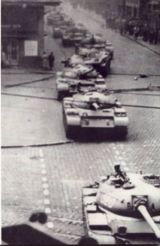
On November 1, Imre Nagy received reports that Soviet forces had entered Hungary from the east and were moving towards Budapest. Nagy sought and received assurances from Soviet ambassador Yuri Andropov that the Soviet Union would not invade, although Andropov knew otherwise. The Cabinet, with János Kádár in agreement, declared Hungary's neutrality, withdrew from the Warsaw Pact, and requested assistance from the diplomatic corps in Budapest and the UN Secretary-General to defend Hungary's neutrality. Ambassador Andropov was asked to inform his government that Hungary would begin negotiations on the removal of Soviet forces immediately.
On November 3, a Hungarian delegation led by the Minister of Defense Pál Maléter were invited to attend negotiations on Soviet withdrawal at the Soviet Military Command at Tököl, near Budapest. At around midnight that evening, General Ivan Serov, Chief of the Soviet Security Police ( NKVD) ordered the arrest of the Hungarian delegation, and the next day, the Soviet army again attacked Budapest.
This second Soviet intervention, codenamed "Operation Whirlwind", was launched by Marshal Ivan Konev. The five Soviet divisions stationed in Hungary before October 23 were augmented to a total strength of 17 divisions. The 8th Mechanized Army under command of Lieutenant General Hamazasp Babadzhanian and the 38th Army under command of Lieutenant General Hadzhi-Umar Mamsurov from the nearby Carpathian Military District were deployed to Hungary for the operation. Some rank-and-file Soviet soldiers reportedly believed they were being sent to Berlin to fight German fascists. By 9:30 p.m. on November 3, the Soviet Army had completely encircled Budapest.
At 3:00 a.m. on November 4, Soviet tanks penetrated Budapest along the Pest side of the Danube in two thrusts: one up the Soroksári road from the south and the other down the Váci road from the north. Thus before a single shot was fired, the Soviets had effectively split the city in half, controlled all bridgeheads, and were shielded to the rear by the wide Danube river. Armored units crossed into Buda and at 4:25 a.m. fired the first shots at the army barracks on Budaõrsi road. Soon after, Soviet artillery and tank fire was heard in all districts of Budapest. Operation Whirlwind combined air strikes, artillery, and the coordinated tank-infantry action of 17 divisions. The Hungarian Army put up sporadic and uncoordinated resistance. Although some very senior officers were openly pro-Soviet, the rank and file soldiers were overwhelmingly loyal to the revolution and either fought against the invasion or deserted. The United Nations reported that there were no recorded incidents of Hungarian Army units fighting on the side of the Soviets.
At 5:20 a.m. on November 4, Imre Nagy broadcast his final plea to the nation and the world, announcing that Soviet Forces were attacking Budapest and that the Government remained at its post. The broadcaster, Free Kossuth Rádió, stopped broadcasting at 8:07 a.m. An emergency Cabinet meeting was held in the Parliament building, but was attended by only three Ministers. As Soviet troops arrived to occupy the building, a negotiated evacuation ensued, leaving Minister of State István Bibó as the last representative of the National Government remaining at post. Awaiting arrest, he wrote a stirring proclamation to the nation and the world.
At 6:00 am on November 4, in the town of Szolnok, János Kádár proclaimed the "Hungarian Revolutionary Worker-Peasant Government". His statement declared "We must put an end to the excesses of the counter-revolutionary elements. The hour for action has sounded. We are going to defend the interest of the workers and peasants and the achievements of the people's democracy." Later that evening, Kádár called upon "the faithful fighters of the true cause of socialism" to come out of hiding and take up arms. However, Hungarian support did not materialize; the fighting did not take on the character of an internally divisive civil war, but rather, in the words of a United Nations report, that of "a well-equipped foreign army crushing by overwhelming force a national movement and eliminating the Government."
By 8:00 am organised defence of the city evaporated after the radio station was seized, and many defenders fell back to fortified positions. Hungarian civilians bore the brunt of the fighting, as Soviet troops spared little effort to differentiate military from civilian targets. For this reason, Soviet tanks often crept along main roads firing indiscriminately into buildings. Hungarian resistance was strongest in the industrial areas of Budapest, which were heavily targeted by Soviet artillery and air strikes. The last pocket of resistance called for ceasefire on 10 November. Over 2,500 Hungarians and 722 Soviet troops had been killed and thousands more were wounded.
Soviet version of events
Soviet reports of the events surrounding, during, and after were remarkably consistent in their accounts. 36 hours after the outbreak of violence, Pravda published an account which set the tone for all further reports and subsequent Soviet historiography:
- on October 23, the "honest" socialist Hungarians demonstrated against mistakes made by the Rákosi and Gerő governments
- fascist, Hitlerite, reactionary, counter-revolutionary hooligans financed by the imperialist west took advantage of the unrest to stage a counter-revolution
- the honest Hungarian people under Nagy appealed to Soviet (Warsaw Pact) forces stationed in Hungary to assist in restoring order
- the Nagy government was ineffective, allowing itself to be penetrated by counter-revolutionary influences, weakening then disintegrating, as proven by Nagy's culminating denouncement of the Warsaw Pact
- Hungarian patriots under Kádár broke with the Nagy government and formed a government of honest Hungarian revolutionary workers and peasants; this genuinely popular government petitioned the Soviet command to help put down the counter-revolution
- the Hungarian patriots, with Soviet assistance, smashed the counter-revolution
The first Soviet report came out 24 hours after the first Western report. Nagy's appeal to the United Nations, or that he was arrested, was not reported. Nor did accounts explain how Nagy went from patriot to traitor. The Soviet press reported calm in Budapest while the Western press reported a revolutionary crisis was breaking out. According to the Soviet account, Hungarians never wanted a revolution at all.
Aftermath
Hungary
Between November 10 and December 19, workers' councils negotiated directly with the occupying Soviets. While they achieved some prisoner releases, they did not achieve a Soviet withdrawal. Thousands of Hungarians were arrested, imprisoned and deported to the Soviet Union, many without evidence. Approximately 200,000 Hungarians fled Hungary, some 26,000 were put on trial by the Kádár government, and of those 13,000 were imprisoned. Former Hungarian Foreign Minister Géza Jeszenszky estimated 350 were executed. Sporadic armed resistance and strikes by workers' councils continued until mid-1957, causing substantial economic disruption.
With most of Budapest under Soviet control by November 8, Kádár became Prime Minister of the "Revolutionary Worker-Peasant Government" and General Secretary of the Hungarian Communist Party. Few Hungarians rejoined the reorganized Party, its leadership having been purged under the supervision of the Soviet Presidium, led by Georgy Malenkov and Mikhail Suslov. Although Party membership declined from 800,000 before the uprising to 100,000 by December 1956, Kádár steadily increased his control over Hungary and neutralized dissenters. The new government attempted to enlist support by espousing popular principles of Hungarian self-determination voiced during the uprising, but Soviet troops remained. After 1956 the Soviet Union severely purged the Hungarian Army and reinstituted political indoctrination in the units that remained. In May 1957, the Soviet Union increased its troop levels in Hungary and by treaty Hungary accepted the Soviet presence on a permanent basis.
The Red Cross and the Austrian Army established refugee camps in Traiskirchen and Graz. Imre Nagy along with Georg Lukács, Géza Losonczy, and László Rajk's widow, Júlia, took refuge in the Embassy of Yugoslavia as Soviet forces overran Budapest. Despite assurances of safe passage out of Hungary by the Soviets and the Kádár government, Nagy and his group were arrested when attempting to leave the embassy on November 22 and taken to Romania. Losonczy died while on a hunger strike in prison awaiting trial when his jailers "carelessly pushed a feeding tube down his windpipe." The remainder of the group was returned to Budapest in 1958. Nagy was executed, along with Pál Maléter and Miklós Gimes, after secret trials in June 1958. Their bodies were placed in unmarked graves in the Municipal Cemetery outside Budapest.
By 1963, most political prisoners from the 1956 Hungarian revolution had been released. During the November 1956 Soviet assault on Budapest, Cardinal Mindszenty was granted political asylum at the United States embassy, where he lived for the next 15 years, refusing to leave Hungary unless the government reversed his 1949 conviction for treason. Due to poor health and a request from the Vatican, he finally left the embassy for Austria in September 1971.
International
Despite Cold War rhetoric by the West espousing a rollback of the domination of Eastern Europe by the USSR, and Soviet promises of the imminent triumph of socialism, national leaders of this period as well as later historians saw the failure of the uprising in Hungary as evidence that the Cold War in Europe had become a stalemate. The Foreign Minister of West Germany recommended that the people of Eastern Europe be discouraged from "taking dramatic action which might have disastrous consequences for themselves." The Secretary-General of NATO called the Hungarian revolt "the collective suicide of a whole people". In a newspaper interview in 1957, Khrushchev commented "support by United States ... is rather in the nature of the support that the rope gives to a hanged man." Twelve years later, when Soviet-led forces ended a similar movement toward liberalization in Czechoslovakia, First Secretary Alexander Dubček, recalling the Hungarian experience, asked his citizens not to resist the occupation.
In January 1957, United Nations Secretary-General Dag Hammarskjöld, acting in response to UN General Assembly resolutions requesting investigation and observation of the events in Soviet-occupied Hungary, established the Special Committee on the Problem of Hungary. The Committee, with representatives from Australia, Ceylon (Sri Lanka), Denmark, Tunisia and Uruguay, conducted hearings in New York, Geneva, Rome, Vienna and London. Over five months, 111 refugees were interviewed including ministers, military commanders and other officials of the Nagy government, workers, revolutionary council members, factory managers and technicians, communists and non-communists, students, writers, teachers, medical personnel and Hungarian soldiers. Documents, newspapers, radio transcripts, photos, film footage and other records from Hungary were also reviewed, as well as written testimony of 200 other Hungarians. The governments of Hungary and Romania refused the UN officials of the Committee entry, and the government of the Soviet Union did not respond to requests for information. The 268-page Committee Report was presented to the General Assembly in June 1957, documenting the course of the uprising and Soviet intervention, and concluding that the Kádár government and Soviet occupation were in violation of the human rights of the Hungarian people. A General Assembly resolution was approved, deploring the repression of the Hungarian people and the Soviet occupation, but no other action was taken.
At the Melbourne Olympics in 1956, the Soviet handling of the Hungarian uprising led to a boycott by Spain, the Netherlands and Switzerland. At the Olympic Village, the Hungarian delegation tore down the Communist Hungarian flag and raised the flag of Free Hungary in its place. A confrontation between Soviet and Hungarian teams occurred in the semi-final match of the water polo tournament. The match was extremely violent, and was halted in the final minute to quell fighting amongst spectators. This match, now known as the " blood in the water match", became the subject of several films. The Hungarian team won the game 4-0 and later was awarded the Olympic gold medal. Several members of the Hungarian Olympic delegation defected after the games.
The events in Hungary produced ideological fractures within the Communist parties of Western Europe. Within the Italian Communist Party (PCI) a split ensued: most ordinary members and the Party leadership, including Palmiro Togliatti and Giorgio Napolitano, regarded the Hungarian insurgents as counter-revolutionaries, as reported in l'Unità, the official PCI newspaper. However Giuseppe Di Vittorio, chief of the Communist trade union CGIL, repudiated the leadership position, as did the prominent party members Antonio Giolitti, Loris Fortuna and many other influential Communist intellectuals, who later were expelled or left the party. Pietro Nenni, the national secretary of the Italian Socialist Party, a close ally of the PCI, opposed the Soviet intervention as well. Napolitano, elected in 2006 as President of the Italian Republic, wrote in his 2005 political autobiography that he regretted his justification of Soviet action in Hungary, and that at the time he believed in Party unity and the international leadership of Soviet communism. Within the Communist Party of Great Britain (CPGB), dissent that began with the repudiation of Stalinism by John Saville and E.P. Thompson, influential historians and members of the Communist Party Historians Group, culminated in a loss of thousands of party members as events unfolded in Hungary. Peter Fryer, correspondent for the CPGB newspaper The Daily Worker, reported accurately on the violent suppression of the uprising, but his dispatches were heavily censored; Fryer resigned from the paper upon his return, and was later expelled from the communist party. In France, moderate communists, such as historian Emmanuel Le Roy Ladurie, resigned, questioning the policy of supporting Soviet actions by the French Communist Party. The French philosopher and writer Albert Camus wrote an open letter, The Blood of the Hungarians, criticizing the West's lack of action. Even Jean-Paul Sartre, still a determined communist, criticised the Soviets in his article Le Fantôme de Staline, in Situations VII.
Commemoration
In December, 1991, the preamble of the treaties with the dismembered Soviet Union, under Mikhail Gorbachev, and Russia, represented by Boris Yeltsin, apologized officially for the 1956 Soviet actions in Hungary. This apology was repeated by Yeltsin in 1992 during a speech to the Hungarian parliament.
On February 13, 2006, the US State Department commemorated the Fiftieth anniversary of the 1956 Hungarian Revolution. US Secretary of State Rice commented on the contributions made by 1956 Hungarian refugees to the United States and other host countries, as well as the role of Hungary in providing refuge to East Germans during the 1989 protests against communist rule. US President George W. Bush also visited Hungary on June 22, 2006, to commemorate the fiftieth anniversary.
After the fall of the communist regime, Imre Nagy's body was reburied with full honours. The Republic of Hungary was declared in 1989 on the 33rd anniversary of the Revolution, and October 23 is now a Hungarian national holiday.
